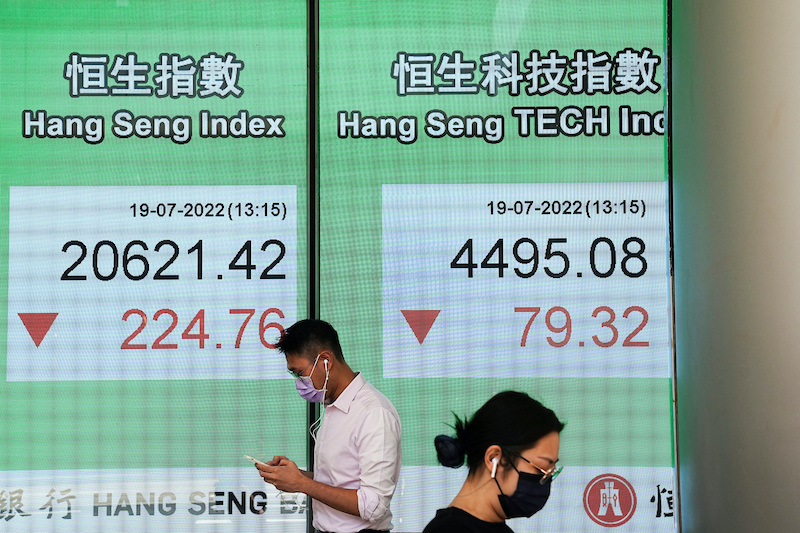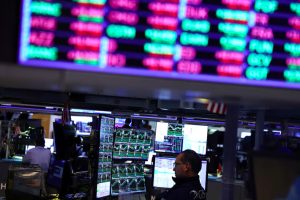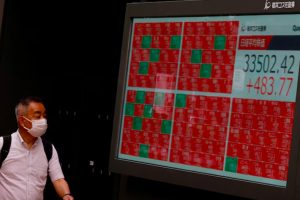Asian stocks ended the week on the front foot, with better-than-expected data out of China and signs central banks were ready to rein in their interest rate campaigns lifting the mood on trading floors.
Chinese gauges of retail sales and industrial output for August topped economists forecasts, providing additional tailwinds from the central bank’s decision overnight to cut banks’ reserve ratio requirements for a second time this year.
That optimism fed into markets across the region – though, paradoxically, mainland China bourses were an outlier – with many investors feeling a turning point had been reached.
Also on AF: Taiwan Slams China’s ‘Unilateral’ Cross-Strait Zone Plan
Japan’s broader Topix share index ended at a more than 33-year high, underpinned by overnight Wall Street gains, with technology stocks leading the gains after the strong market debut of SoftBank Group’s Arm Holdings.
The broader Topix rose 0.95% to end at 2,428.38, its highest close since June 1990 and rose 2.95% for the week. The benchmark Nikkei jumped 1.10% to finish at 33,533.09, its highest closing level since July 3 and rose 2.8% for the week.
Adding to positive sentiment, SoftBank Group’s Arm was valued at nearly $60 billion in a muscular Nasdaq debut overnight, with the chip designer’s shares soaring nearly 25% in their first day of trading.
Shares in SoftBank Group rose as much as 5% earlier in the session but trimmed some gains to end 2.08% higher.
Mainland China stocks fell though, despite data showing the country’s recovery was stabilising and the central bank deciding to cut the amount of cash that banks must hold as reserves.
“Although these easing measures are very welcome, they are definitely not enough to turn things fully around … the real problem is the lack of effective credit demand instead of lack of credit supply,” Nomura’s Lu said.
But a separate report showed the biggest drop in new home prices in 10 months – another reminder of the property sector’s struggles, after Moody’s cut the sector’s outlook to negative on Thursday.
Energy Shares Boost Hong Kong
The Shanghai Composite Index fell 0.28%, or 8.81 points, to 3,117.74, while the Shenzhen Composite Index on China’s second exchange edged back 0.31%, or 5.90 points, to 1,911.12.
However, energy shares jumped 1.7% in Hong Kong, as oil prices rose to their highest level in 10 months following China’s latest measures to boost recovery. The benchmark Hang Seng Index rose 0.75%, or 134.97 points, to 18,182.89.
Elsewhere across the region, in earlier trade, Sydney, Singapore, Seoul, Mumbai, Taipei and Wellington were also well in positive territory. MSCI’s broadest index of Asia-Pacific shares rallied 0.79%.
US S&P 500 futures pointed to a 0.18% rise, after the cash index rallied 0.84% on Thursday. Pan-European Stoxx 50 futures indicated 0.7% higher.
Meanwhile, US data showed producer prices increased by the most in more than a year in August and retail sales also rose more than expected. But both of those figures were swelled by higher gasoline prices.
As a result, traders stuck to bets for the Federal Reserve to skip a rate hike next week, in what might be the end of the tightening cycle.
US Dollar Rallies
The dollar index is on track for a ninth straight weekly advance, the longest run in nine years.
The greenback stuck close to a six-month peak from overnight against major peers, buoyed by robust US economic data, while the euro sagged following the European Central Bank’s signal that Thursday’s rate hike was probably the last this cycle.
The overall improving economic outlook, however, bolstered the Chinese yuan, which gained about 0.2% to 7.2731 per dollar in offshore markets.
Australia’s dollar, which often trades as a proxy for the country’s top trading partner, rose 0.39% to $0.6466.
However, a gauge of the US dollar against six of its biggest developed-market peers stuck close to the six-month peak it reached overnight, buoyed primarily by the euro’s steep overnight slide.
The so-called US dollar index edged down 0.15% to 105.25, after hitting the highest since early March at 105.43 on Thursday.
In energy markets, crude oil extended its rise in Asia trading, touching fresh highs since November.
Brent crude futures rose 62 cents, or 0.7%, to $94.32, while the US West Texas Intermediate crude (WTI) was up 71 cents, or 0.8%, at $90.87.
Key figures
Tokyo – Nikkei 225 > UP 1.10% at 33,533.09 (close)
Hong Kong – Hang Seng Index > UP 0.75% at 18,182.89 (close)
Shanghai – Composite < DOWN 0.28% at 3,117.74 (close)
London – FTSE 100 > UP 0.73% at 7,728.75 (0932 BST)
New York – Dow > UP 0.96% at 34,907.11 (Thursday close)
- Reuters with additional editing by Sean O’Meara
Read more:
China’s Factory and Retail Sales Pick Up, But Property Still a Drag
Moody’s Sounds Alarm For China’s Troubled Property Sector
China Central Bank Seen Boosting Liquidity, Keeping Rates Steady
Nikkei Surges on Fed Bets, Hang Seng Gains Despite EU Probe
























